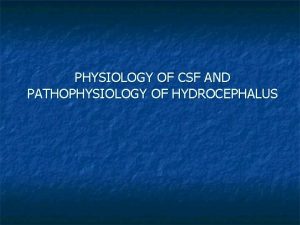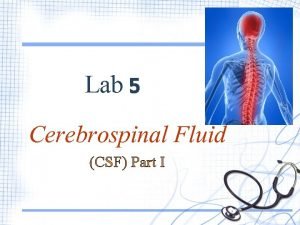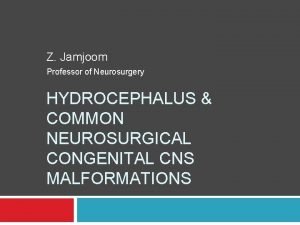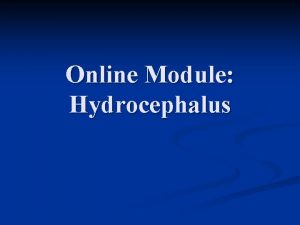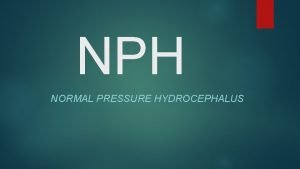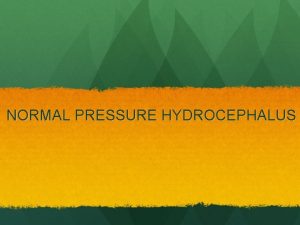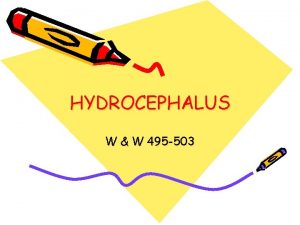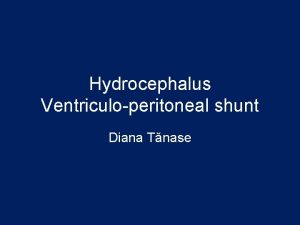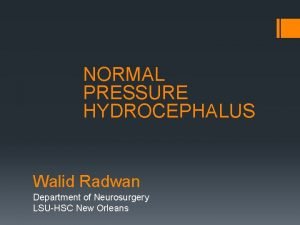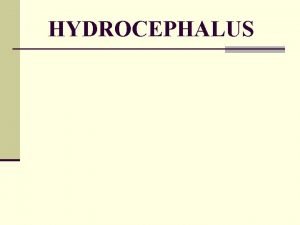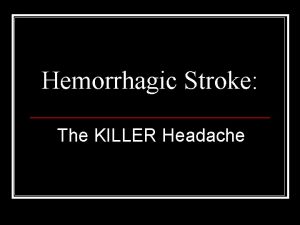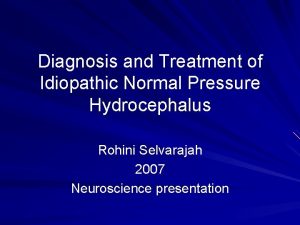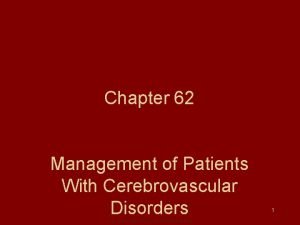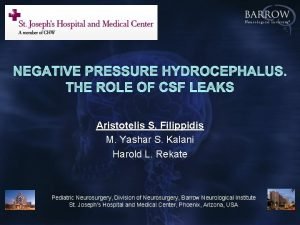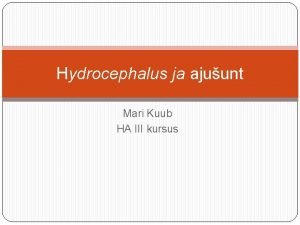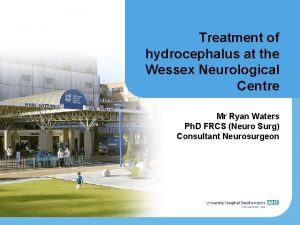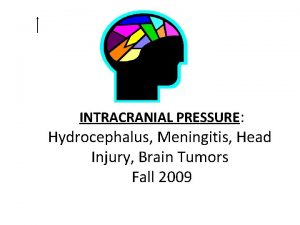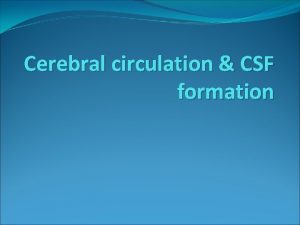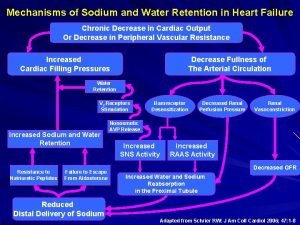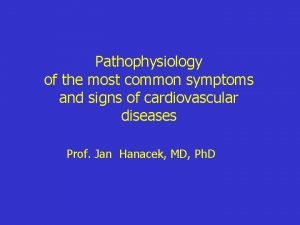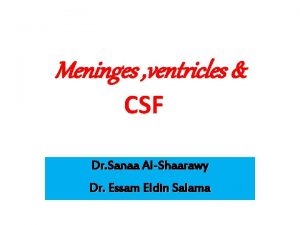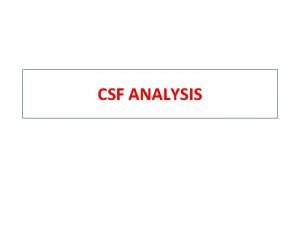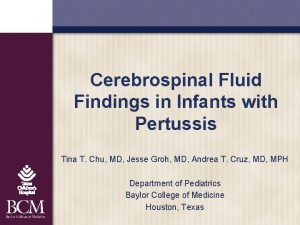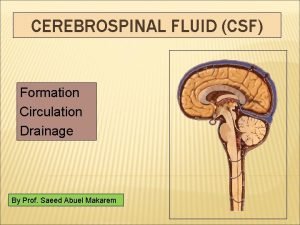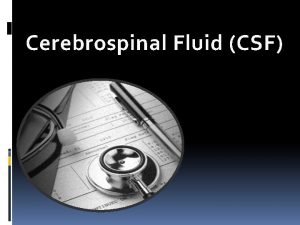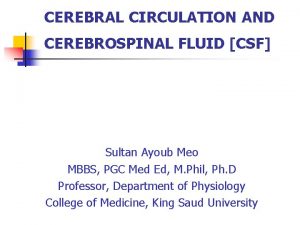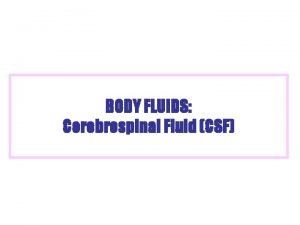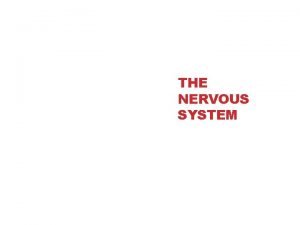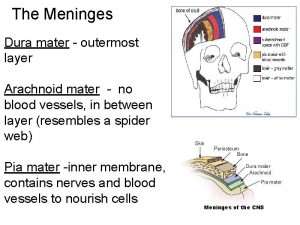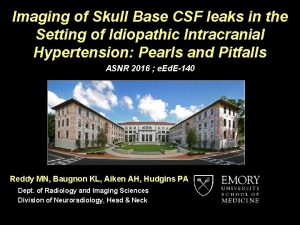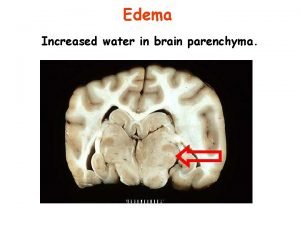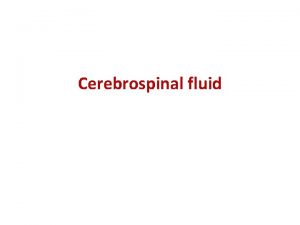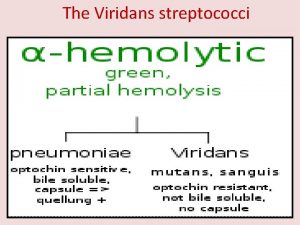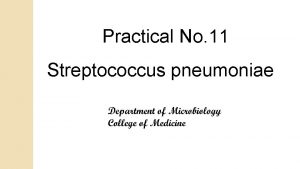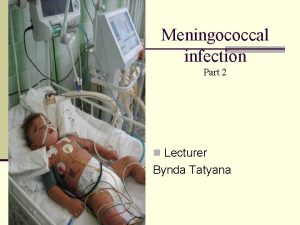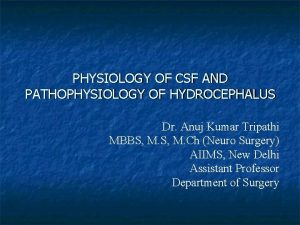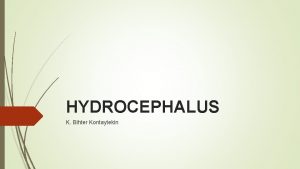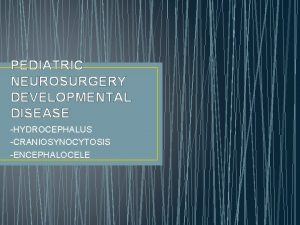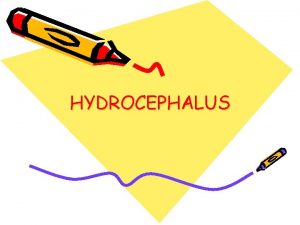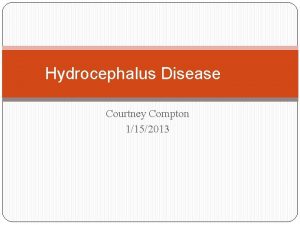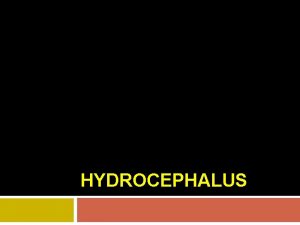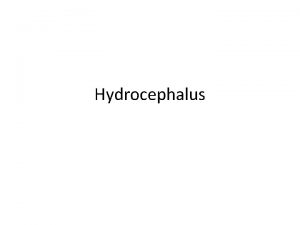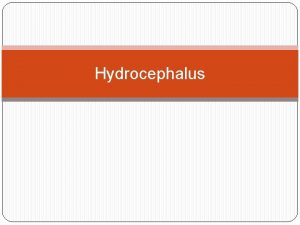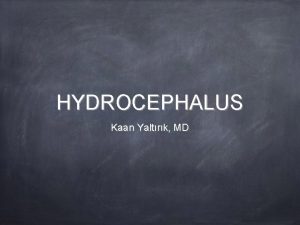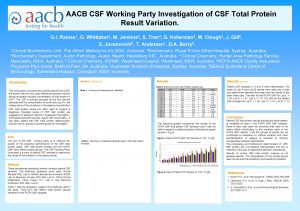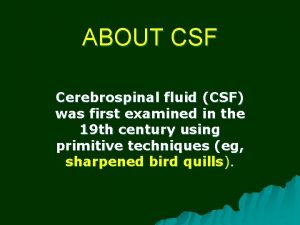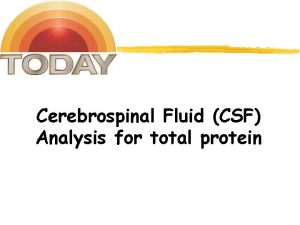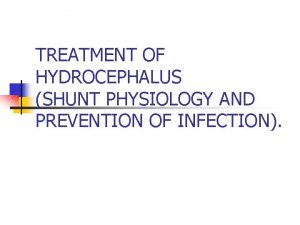PHYSIOLOGY OF CSF AND PATHOPHYSIOLOGY OF HYDROCEPHALUS Introduction














































- Slides: 46

PHYSIOLOGY OF CSF AND PATHOPHYSIOLOGY OF HYDROCEPHALUS

Introduction n Dynamic component of CNS n Invaluable tool to diagnosis n Physiological reservoir of human proteome n Reflects the physiologic state of CNS

Historical account n n n n Hippocrates described fluid in brain Galen described ventricles Vesalius showed the anatomy Megendi performed first cisternal puncture in animals Quinke performed first LP Dandy was credited first ventricular puncture Quekensted did first cisternal puncture in humans.

Functions of CSF n Mechanical cushion to brain n Source of nutrition to brain n Excretion of metabolic waste products n Intracerebral transport medium n Control of chemical environment n Autoregulation of intracranial pressure

Production of CSF n Choroidal n Extrachoroidal n Ependyma n ? Neighboring brain substance

Facts of interest n n Only choroidal CSF production is tightly regulated active process CSF secretion shows diurnal variation with peak in the morning.

Factors affecting production n Vascular bed autoregulation n Intracranial pressure n Brain metabolism n Drugs

Absorption of CSF n Arachanoid granulations n Along the olfactory nerves n Extracellular spaces in brain n Brain substance ( glial cells).

Factors affecting absorption n Intracranial pressure

Quantitative dynamics n Daily secretion: n Total CSF volume: n Ventricular n Cisternal n Spinal

Techniques of CSF analysis n Lumber puncture n Cisternal puncture n Ventricular puncture

Lumber puncture n n Diagnostic indications: n Infective pathology n Inflammatory pathology n Subarachanoid hemorrhage n Malignancy and spread n Pressure recordings n Cisternography, myelography, Therapeutic indications: n CSF drainage n Drug delivery

Contraindications n n Absolute n Posterior fossa mass n Coagulopahty, blood dyscrasias n Known spinal AVM Relative n Raised ICT (guarded LP) n Local infection

Technique n Positioning n Cleaning and draping n Puncture n CSF

Complications n Post LP headaches n Hematoma n Infection n Neural injury n Iatrogenic dermoids

Other methods n Cisternal puncture n Lateral cervical puncture n Ventricular puncture

Ventriculostomy n Dandy`s point n Keen`s point n Frazier`s point n Kocher`s point

Analysis Glucose 60 -90 ≥ 0. 66 Proteins 35 mg/dl 0. 005 globulins 10 -50 mg/L 0. 001 RBC 0 -1 WBC 0 -1 (L) Lactate 1. 6

Diagnostic characteristics Type Sugar Cells Lactate Bacterial Very low Neutrophils Increased Fungal low L/N - Viral Normal to low L/N - Aseptic Normal Neutrophils Normal Post operative Normal Neutrophils (≥ 1000)

Hydrocephalus n Definition n Imbalance between production and absorption of CSF leading to accumulation of fluid in the ventricular system leading to elevation of intracranial pressure.

Epidemiology n n n Infantile HCP: 3 -4 per 1000 LB As a single congenital disorder: 0. 9 -1. 5 per 1000 live births Associated with SD: 1. 3 -2. 9 per 1000 LB

Classification n n Communicating n AKA extraventricular, Noncommunicating n AKA obstructive n n Triventricular Biventricular


Pathogenesis n Obstruction of CSF pathways leading to decreased absorption n Increased production n Increased venous pressure

Increased production n Choroid plexus papilloma

Decreased absorption n Due to anatomical block in the pathways n Block at arachanoid granulations level

Increased venous pressure n n Evidence with this theory n VOGM n Experimental studies in animals Evidence against this theory n Ligation of various sinuses doesn’t cause HCP n Experimental studies

Pathology of hydrocephalus n Atrophy of white matter n Spongy edema of brain n Fibrosis of choroid plexuses n Stretching and denuding of ependyma n Fenestration of septum pellucidum n Thinning of interhemispheric commisures

Acute HCP n Cerebral, IV or cerebellar hematoma n Paraventricular tumors n Gunshots n Subarachanoid hemorrhage n Acute head injuries n Shunt malfunction.

Progression n Ventricular dilatation n Occipital and frontal horns f/b temporals n Anterior and posterior recess of TV n Fourth ventricle n Third ventricular balloning

Hydrocephalic edema n Available space in the cavity consumed n n Stretching and denuding of ependyma n Edema of white matter n

Mechanism n Stasis of brain interstitial fluid n Reflux of CSF into the periventricular area n Increase in cerebral capillary permeability

Progression n Dorsal angles of lateral ventricle n 3 -6 hrs Centrum semiovale n 19 -24 hrs Diffuse n afterwards

Chronic HCP n Compensatory mechanisms in chronic HCP n Expansion of skull n Contraction of cerebral vascular volume n White matter atropy and ventricular enlargement n Decreased rate of CSF formation. n Diversion of CSF flow to alternative pathways

Changes in cerebral circulation n n n Increased venous pressure Delayed emptying of cerebral veins Narrowing of cerebral arteries Prolongation of circulation time Reduced cerebral blood flow Lowering of CMRO 2 Reduced glucose metabolism

Clinical features n Age n Expansibility of skull bones n Type of HCP n Duration of HCP

Pediatric hydrocephalus n n n n Enlargement of head Thin and glistening scalp Tense, bulging fontanalles Dilated and tortuous scalp veins unilateral or bilateral abducent palsies Cracked pot or macewen`s sign Hypopituitarism and growth retardation Transillumination of skull

Adult acute HCP n Headache, nausea, vomitting n Alteration of sensorium n Visual obscurations n Perinaud`s syndrome n Progression to herniation syndromes

Adult chronic HCP n n n n Bifrontal generalized headache, vomitting Papilloedema and secondary optic atrophy Congnitive deficits Unilateral or bilateral abducent palsies Upward gaze palsy Spastic quadriparesis, dysmetria, Bitemporal hemianopia Endocrine disturbances

Normal pressure hydrocephalus n “Hydrocephalus with normal CSF opening pressure on lumber puncture and absence of papilloedema”

Pathophysiology n n Intermittant rise of CSF pressure causing ventricular dilatation. Intraventricular pressure head is decreased

Basis of clinical symptoms n Gait problems n Urinary incontinence n Memory problems

Arrested hydrocephalus n Definitions n CSF pressure has normalized n Pressure gradient between ventricles and parenchyma has been dessipated n Ventricular size remains stable or decrease n New neurological deficits do not appear n Advancing psychomotor development with age.

Pediatric NPH n Enlarged head usually in or above ninth percentile n History of delayed psychomotor development n Mild to moderate mental retardation n Glib verbal abilities n Mild spastic paraparesis

Hydrocephalus ex vacuo n Cerebral atrophy and dilatation of sulci n Intracranial pressure is normal n Absence of periventricular edema n Absence of retrograde filling Isotope cisternography

n Thank you
 Functions of csf
Functions of csf Csf pathway
Csf pathway Waistline
Waistline Medial lateral distal proximal
Medial lateral distal proximal Chapter 1 an introduction to anatomy and physiology
Chapter 1 an introduction to anatomy and physiology Complication of hydrocephalus
Complication of hydrocephalus Communicating hydrocephalus
Communicating hydrocephalus Acetazolamide dose in hydrocephalus
Acetazolamide dose in hydrocephalus Triad nph
Triad nph Dandy walker syndrome
Dandy walker syndrome Kocher's point
Kocher's point Macrocephaly vs hydrocephalus
Macrocephaly vs hydrocephalus Differential diagnosis of hydrocephalus
Differential diagnosis of hydrocephalus Complications of hydrocephalus
Complications of hydrocephalus N
N Brain hemorrhage
Brain hemorrhage Complications of hydrocephalus
Complications of hydrocephalus Nursing management of stroke
Nursing management of stroke Neck wrapping for low-pressure hydrocephalus
Neck wrapping for low-pressure hydrocephalus Hydrocephalus
Hydrocephalus Normal pressure hydrocephalus triad
Normal pressure hydrocephalus triad Preoperative nursing care for craniotomy
Preoperative nursing care for craniotomy Function of csf
Function of csf Pathophysiology of sodium and water retention
Pathophysiology of sodium and water retention Pathophysiology signs and symptoms
Pathophysiology signs and symptoms Battle sign
Battle sign Tentorium cerebelli
Tentorium cerebelli Where is cerebrospinal fluid present
Where is cerebrospinal fluid present Cerebrospinal fluid analysis
Cerebrospinal fluid analysis Csf normal values
Csf normal values Subarachnoid space
Subarachnoid space Csf color
Csf color Amount of csf produced per day
Amount of csf produced per day Gold seal bearer
Gold seal bearer Normal csf analysis
Normal csf analysis Pain in brain stem
Pain in brain stem Cerebrospinal fluid (csf)
Cerebrospinal fluid (csf) Csf
Csf Csf leak
Csf leak Brain parenchyma
Brain parenchyma Normal csf composition
Normal csf composition Autodiscover.csf.technion.ac.il
Autodiscover.csf.technion.ac.il Streptococcus pneumoniae quellung reaction
Streptococcus pneumoniae quellung reaction Sama csf
Sama csf Inulin fermentation test streptococcus pneumoniae
Inulin fermentation test streptococcus pneumoniae Csf reabsorption
Csf reabsorption Partially treated bacterial meningitis csf
Partially treated bacterial meningitis csf
